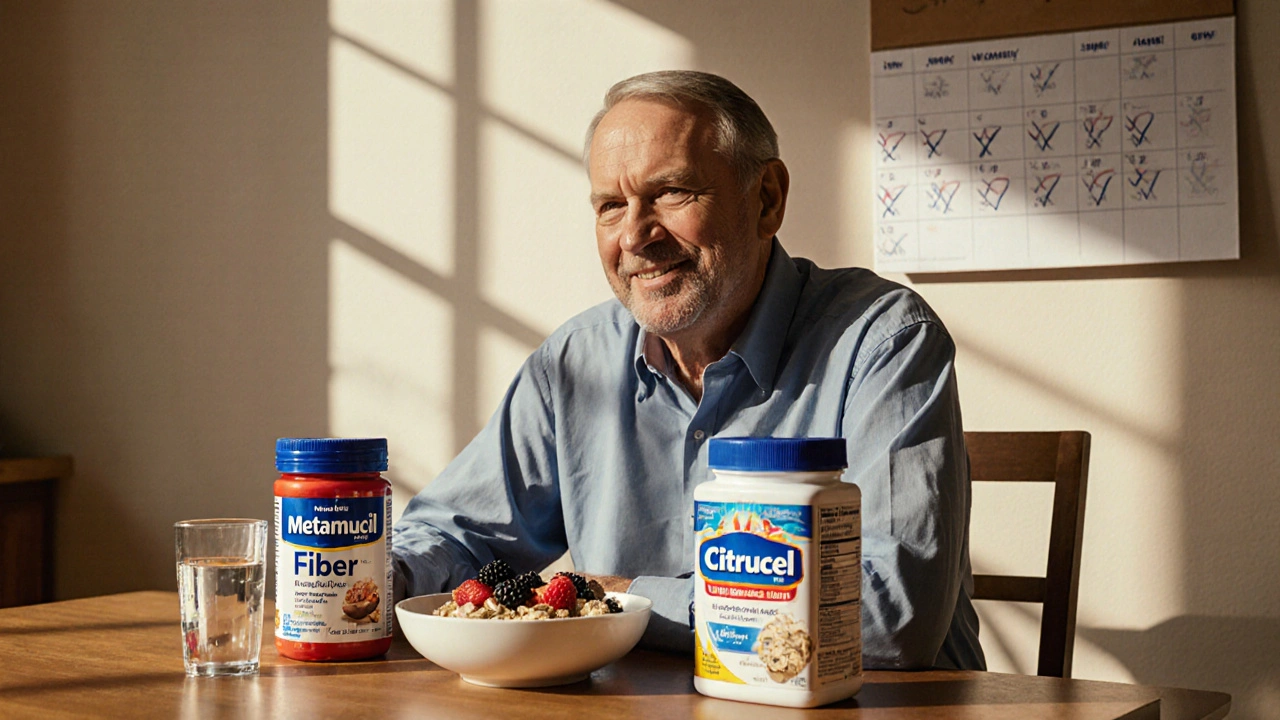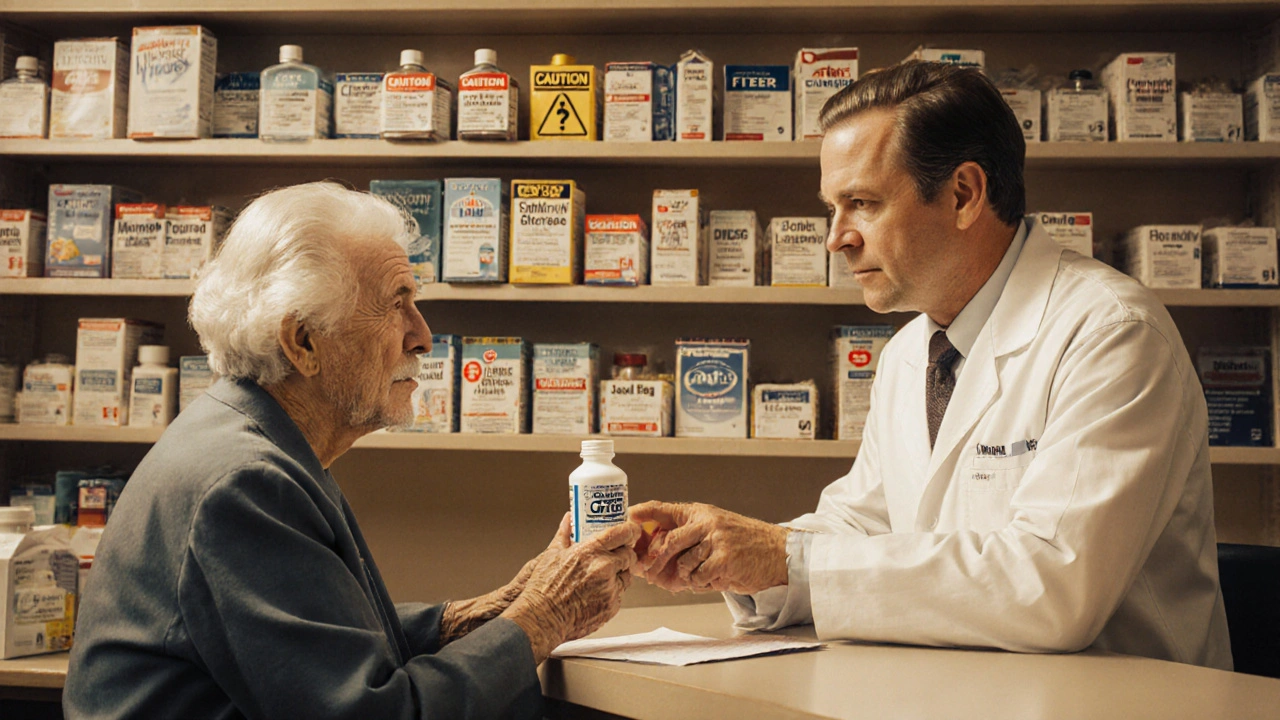OTC Constipation Remedies: Fiber, Stool Softeners, and Laxatives Explained
 Nov, 17 2025
Nov, 17 2025
What’s Really Working for Constipation? Not All OTC Remedies Are Created Equal
If you’ve ever sat on the toilet for 20 minutes with no result, you know how frustrating constipation can be. It’s not just uncomfortable-it can make you feel bloated, sluggish, and even anxious. The good news? You don’t need a prescription to find relief. Over-the-counter options like fiber supplements, stool softeners, and laxatives are on every pharmacy shelf. But here’s the catch: not all of them work the same way, and some can do more harm than good if used the wrong way.
According to the American Gastroenterological Association, about 1 in 6 adults deal with constipation regularly-and that number jumps to 1 in 3 for people over 60. With so many products out there, it’s easy to grab whatever’s cheapest or most advertised. But if you’re still stuck after a few days, you’re probably not using the right tool for the job.
Fiber Supplements: The Gentle Starter
Fiber isn’t flashy, but it’s the safest first step. Products like Metamucil (psyllium) and Citrucel (methylcellulose) work by soaking up water in your gut and turning into a soft, bulky gel that pushes stool along. Think of it like a sponge that swells up and gently moves things along.
Here’s what you need to know:
- It takes 12 to 72 hours to work-don’t expect instant results.
- You must drink at least 8 ounces of water with each dose. Skip this, and you risk blockage.
- Start slow: 5 grams a day for a few days, then increase to 25-30 grams daily. Jumping straight to full dose can cause serious bloating and gas.
- Studies show about 55% of people see improvement with fiber, compared to 35% on placebo.
Fiber is ideal for long-term use. It’s not addictive, doesn’t irritate your gut, and even helps lower cholesterol. If you’re already eating veggies and whole grains but still constipated, fiber supplements can bridge the gap. Most bottles cost $8-$15 for 30 doses-about 25-50 cents per serving.
Stool Softeners: Often Overhyped
Docusate sodium (Colace) is one of the most popular OTC options. It’s marketed as a “gentle” fix, and many doctors hand out samples after surgery or childbirth. But here’s the truth: it doesn’t work well on its own.
Multiple clinical trials show stool softeners are only about 15-20% more effective than a sugar pill. That’s barely better than chance. They work by letting water and fat seep into hard stool, making it easier to pass-but if your stool is just dry and compacted, not stuck, they won’t help much.
On Amazon, Colace has a 2.8 out of 5 rating. Over 60% of reviews say it had “minimal to no effect.” That’s not because it’s broken-it’s because it’s not designed for true constipation. It’s better for preventing straining after surgery or during pregnancy, not for clearing out a backed-up colon.
Cost? Around $7-$15 for 100 capsules. But if you’re serious about relief, don’t rely on this alone.
Osmotic Laxatives: The Gold Standard
If you’ve tried fiber and it didn’t help, this is where you should go next: polyethylene glycol (PEG). That’s the active ingredient in MiraLax and its generic versions.
Here’s why experts like Dr. Brian Lacy from Dartmouth-Hitchcock call PEG the first-line treatment for chronic constipation:
- It draws water into the colon naturally-no nerve stimulation, no cramping.
- Works in 1-3 days, but once it starts, it’s consistent.
- 70-80% of users report significant improvement-far better than fiber or stool softeners.
- Can be used safely for months, even years, without losing effectiveness.
Studies comparing PEG to other laxatives show it’s more effective than lactulose, senna, and even some prescription drugs. It’s also gentler: only 15-20% of users report side effects, compared to 25-35% with stimulants.
Price? Around $12-$22 for 30 doses. Generic PEG costs as little as $8 at Walmart or Costco. It’s not flashy, but it’s the most evidence-backed option you can buy without a script.
Pro tip: Mix one capful (17 grams) in water or juice after dinner. You’ll usually have a bowel movement the next morning. Start with half a cap if you’re new to it-some people get loose stools at first.

Stimulant Laxatives: Fast, But Risky
Bisacodyl (Dulcolax) and senna (Ex-Lax) are the quick fixes. They work by directly irritating the colon lining to trigger contractions. If you need results fast-say, before a flight or a big event-they can deliver in 6-12 hours.
But here’s the problem:
- 25-30% of users get painful cramps.
- Long-term use can damage your colon’s natural ability to contract-leading to a condition called “cathartic colon.”
- They’re not safe for daily use. The AGA recommends no more than one week straight.
On Reddit, users describe Dulcolax as “effective but brutal.” One wrote: “It worked in 4 hours, but I was in the bathroom for the next 8.” Another said, “I used it every day for three months. Now I can’t go without it.”
These aren’t rare stories. Studies show 18% of people stop using stimulant laxatives because of side effects-double the rate of PEG users.
Cost is low: $5-$14 for 30 tablets. But the real cost is your colon’s health. Use these only as rescue tools-not daily crutches.
Saline Laxatives: Use With Extreme Caution
Milk of Magnesia and magnesium citrate work fast-sometimes in under an hour. They pull water into the intestines like a sponge, flushing everything out.
But they’re dangerous if used regularly. Magnesium can build up in your system, especially if you have kidney issues. Symptoms of overdose include nausea, weakness, irregular heartbeat, and dehydration.
The Mayo Clinic warns against using saline laxatives more than once every few days. They’re fine for occasional use-say, after a heavy meal or during travel-but not for ongoing constipation.
Price? $4-$15 per bottle. But the risk isn’t worth the convenience unless you’re in a real pinch.
What Should You Actually Use?
Let’s cut through the noise. Here’s a simple, evidence-based plan:
- Start with fiber. Try 25-30 grams daily from food and supplements. Give it 3-5 days. Drink water.
- If no luck, switch to PEG (MiraLax or generic). One capful daily, mixed in liquid. Keep going for up to 6 months if needed.
- Only use stimulants (Dulcolax, senna) for emergencies. No more than 1-2 times a week.
- Avoid stool softeners and saline laxatives for routine use. They’re not effective enough-or too risky.
And here’s what not to do:
- Don’t mix laxatives. Combining types increases side effects without improving results.
- Don’t use stimulants longer than a week without seeing a doctor.
- Don’t ignore symptoms like blood in stool, weight loss, or constant pain. Constipation can be a sign of something serious.

When to Call a Doctor
Most constipation is harmless and responds to OTC remedies. But if you’ve tried the right treatments for 7 days with no result, it’s time to talk to a professional. Other red flags:
- Unexplained weight loss
- Rectal bleeding
- Severe abdominal pain
- Constipation that started suddenly after age 50
- Feeling like you can’t fully empty your bowels
These aren’t normal. They could point to conditions like colon cancer, hypothyroidism, or nerve damage from diabetes. Don’t wait. Get checked.
Real People, Real Results
On Amazon, MiraLax has over 28,000 reviews with a 4.5-star rating. Common comments: “Works gently,” “No cramps,” “Finally feel normal again.”
Meanwhile, Dulcolax has 15,000 reviews and a 4.1-star rating-but the negative ones are loud: “I thought it was a miracle until I got addicted,” “I couldn’t go without it after two weeks.”
One man in his 60s, who’d been constipated for years after taking opioids for back pain, switched from senna to PEG. “I was scared to stop the stimulants,” he wrote. “But after two weeks on MiraLax, I didn’t need anything else. I felt like I got my life back.”
The Bottom Line
OTC constipation remedies aren’t a one-size-fits-all solution. Fiber is the foundation. PEG is the most reliable fix for ongoing issues. Stimulants are for emergencies. Stool softeners and saline laxatives? Save them for rare cases.
The market is full of hype, but the science is clear: polyethylene glycol is the most effective, safest, and best-studied option for long-term relief. It’s not the flashiest, but it’s the one that actually works-without wrecking your gut.
Fix your constipation the right way. Your colon will thank you.
Can I take fiber and MiraLax together?
Yes, you can. In fact, many people do. Fiber helps keep things moving regularly, while MiraLax pulls in water to soften stool. Just make sure you’re drinking enough water-both need hydration to work. Start with fiber daily, and add MiraLax only if you’re still struggling after a few days.
How long can I safely use MiraLax?
MiraLax is safe for daily use up to 6 months, based on clinical trials. Many people use it long-term with no issues. The key is to use the lowest effective dose-usually one capful per day. If you’re using it longer than 6 months, talk to your doctor to rule out underlying causes.
Why does my stool feel soft but I still can’t pass it?
That’s called “pelvic floor dysfunction.” Your colon may be working fine, but the muscles around your anus aren’t relaxing properly. This is common after childbirth, surgery, or long-term straining. Stool softeners won’t help here. Try pelvic floor physical therapy or biofeedback. If you’re stuck despite soft stool, see a specialist.
Are generic laxatives as good as brand names?
Yes, for most types. Generic PEG (polyethylene glycol) has the same active ingredient as MiraLax and works identically. The same goes for senna and bisacodyl. The only difference is price-generics cost 30-70% less. Always check the active ingredient on the label, not the brand name.
Can constipation be caused by something I’m eating?
Absolutely. Too much dairy, processed food, or low-fiber meals can slow things down. Dehydration is another big one-even mild dehydration makes stool harder. Try cutting back on cheese, white bread, and fried food for a week. Drink more water. Add beans, oats, berries, and leafy greens. Often, diet alone fixes it.
Is it normal to need laxatives every day?
No. If you’re relying on laxatives daily for more than a few weeks, you should see a doctor. Your body may have become dependent, or there could be an underlying issue like slow transit constipation or a nerve problem. Daily use of stimulant laxatives is especially risky. PEG is safer for daily use, but even then, it’s better to find and fix the root cause.

kora ortiz
November 17, 2025 AT 22:06Stop chasing quick fixes. This isn't a sprint, it's a lifestyle.
Jeremy Hernandez
November 19, 2025 AT 18:33Tarryne Rolle
November 21, 2025 AT 00:43Kyle Swatt
November 22, 2025 AT 01:56Life's too short to sit there like a statue.
Deb McLachlin
November 23, 2025 AT 22:48saurabh lamba
November 25, 2025 AT 13:37Kiran Mandavkar
November 26, 2025 AT 19:09Eric Healy
November 28, 2025 AT 14:26Shannon Hale
November 29, 2025 AT 03:51